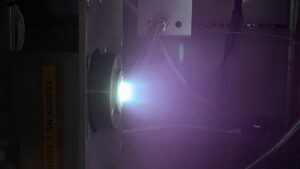Air Force’s AFWERX program to test using iodine as a propellant in the company’s Maxwell electric thrusters. The award will fund work on a prototype version of that thruster.
Iodine offers a number of advantages over conventional propellants like xenon and krypton, said Beau Jarvis, chief executive of Phase Four, in an interview. Iodine doesn’t require high-pressure storage, saving on weight and complexity, which makes it particularly useful for small satellites where mass and volume are constrained.
It is also potentially much cheaper, given both the reduced size and complexity of the thruster system as well as the far lower cost of iodine compared to xenon, which Phase Four has been using for its Maxwell thruster. “Well over 50% of the cost of that unit is tied up on the fluid side: the storage tank, the high-pressure valves and the cost of xenon,” he said.
Iodine can be stored more densely, and because of the lack of high-pressure vessels can be fueled earlier in launch processing flow. That increased density means that spacecraft can carry more fuel, enabling more maneuvers while in orbit while reserving propellant for end-of-life disposal maneuvers.
“More efficient smallsat propulsion systems, such as an iodine radiofrequency thruster, will enable new missions in the areas of remote sensing, space surveillance, and communications, among others,” Umair Siddiqui, chief technology officer of Phase Four, said in a statement.
The traditional drawback about iodine, though, is that is corrodes thruster components. “Iodine is notorious for corroding cathodes. You can temporarily use iodine in a legacy electric propulsion system, but it shortens the lifetime dramatically because it does corrode the cathode, such that it’s not really commercially viable,” Jarvis said.
That is not an issue for Maxwell, which uses radiofrequency technology rather than cathodes to accelerate the propellant and generate thrust. Phase Four will demonstrate that in lab testing under the Phase 2 SBIR award, and Jarvis said the company hopes to then win a larger Phase 3 award to create a flight-qualified version of the iodine Maxwell thruster.
Phase Four flew the first of its xenon Maxwell thrusters in January on two satellites that were part of the SpaceX Transporter-1 rideshare mission. Jarvis said the customer for those thrusters remains undisclosed for now, but that the thrusters were working well. “All the data that our customer has shared with us when they’ve done firings of the thruster in space match what we observed in the lab during testing and flight qualification,” he said.
Two more Maxwell thrusters have been integrated into satellites for launch in May or June, with as many 10 thrusters launched by the end of the year. “What we’re doing now is we’re ramping up our production capability,” he said, including hiring several more employees.



